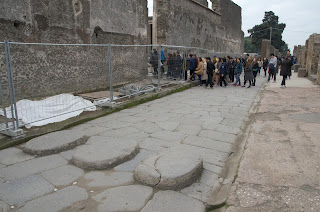 |
| Mouth covered to try to keep out the ash |
We have all heard the story of Pompeii. In AD 79, Mt.
Vesuvius erupted and the city of Pompeii was quickly covered in ash killing
many of the townspeople and preserving the site for 2000 years when it was
discovered in the 18
th century. Most of us have heard about the
beautiful artwork, particularly the mosaics, and more particularly the erotic
mosaics that were saved by the ashes. We have heard about the bodies that were
found as they were covered by the ashes. To this story, I can add little.
Entrance to Pompeii could not be easier. We emerged from the
train, turned right, walked on block past eateries where we would have lunch
after finishing our tour, and reached the ticket office. A walk up the ramp
past the docks, now 5 kilometers from the beach, and through the arch led us
into town to begin our tour.
 |
| Look carefully and you can see the tie-ups for the boats |
Our guide walked us through some of the site and then we spent
another couple of hours seeing more on our own. I was much surprised when the
guide left us that we had seen only about 10% of the site. In the next two
hours we would see another 10%. We chose not to walk another 3 or 4 kilometers
to see the great amphitheater. To see that and the rest of the site would take
another couple of days at least.
 |
| Go to Naples to see what was there |
 |
| The original is in Naples |
 |
| The original is in Naples. This is Darius fleeing Alexander. |
I was surprised at how much is not there. As we began
reading about Pompeii in preparation for our visit we learned that most of the
art had been removed soon after the discovery and taken to Naples where it
would eventually be housed in the Naples National Archaeological Museum. Some
of what is left in Pompeii is actually a reproduction.
 |
| Stepping stones to cross the streeet |
 |
| Pedestrians only |
Street pavement includes white squares of broken pottery placed
to help those walking the streets at night. Sidewalks were raised so that
people could avoid the water gushing down the streets for cleaning. Raised
stones were placed so people could avoid the water when crossing the street. These
stones were divided to allow carts to pass. The main street, Via Abbondanza,
was blocked off from carts by larger stones creating a pedestrian-only zone.
 |
| House interior. Note the atrium in front and garden behind |
Walking through some homes was interesting. The larger ones
had several rooms including an atrium and a garden. The atrium acted as an
entry way and was surrounded by bedrooms. The garden behind the atrium provided
a cooler area for relaxing and entertaining during the hot summers. Temperatures
in this part of Italy commonly reach 100 degrees and above.
At least 25 brothels have been identified so far in Pompeii.
Most of these are single rooms and part of a tavern or eating establishment or
incorporated into a bath house. Only one was built as a brothel. It has ten
rooms in a two-story building and one bathroom downstairs. Pictures were used
to advertise the possibilities in the brothel. In one bathhouse, they were numbered
so that the patrons could tell the prostitute by number what he wanted to do.
An ingenious system for those unable to read or write.
As we knew, the Romans were excellent hydrologists making
excellent use of waterways to bring water to the people and to flush out the waste.
A 100-mile long aqueduct brought water to town. Toilets had running water
underneath to carry away the waste. Fountains are conveniently located
throughout town to provide drinking and washing water. They have now been
fitted with modern faucets providing water to tourists. The faces on the fountains
identified the street helping locals and visitors find their way about town.
 |
| Bakery. the top part turns and the grain comes out the bottom as flour. |
 |
| Serving stations |
The theater and the other public spaces provided a lot of area where people could gather and enjoy each other's public company.
Finishing with a few pictures showing construction techniques.
 |
Designed for shipping.
The narrow part on the bottom goes into a hole on the ship to keep the canister steady. |
 |
| Kind of like legos |
 |
After this is plastered, it is a beautiful fluted column.
I was intrigued by the interesting shape of the bricks. |
We spent about four hours in town before leaving to have
lunch and catch a train back to Sorrento.


























No comments:
Post a Comment